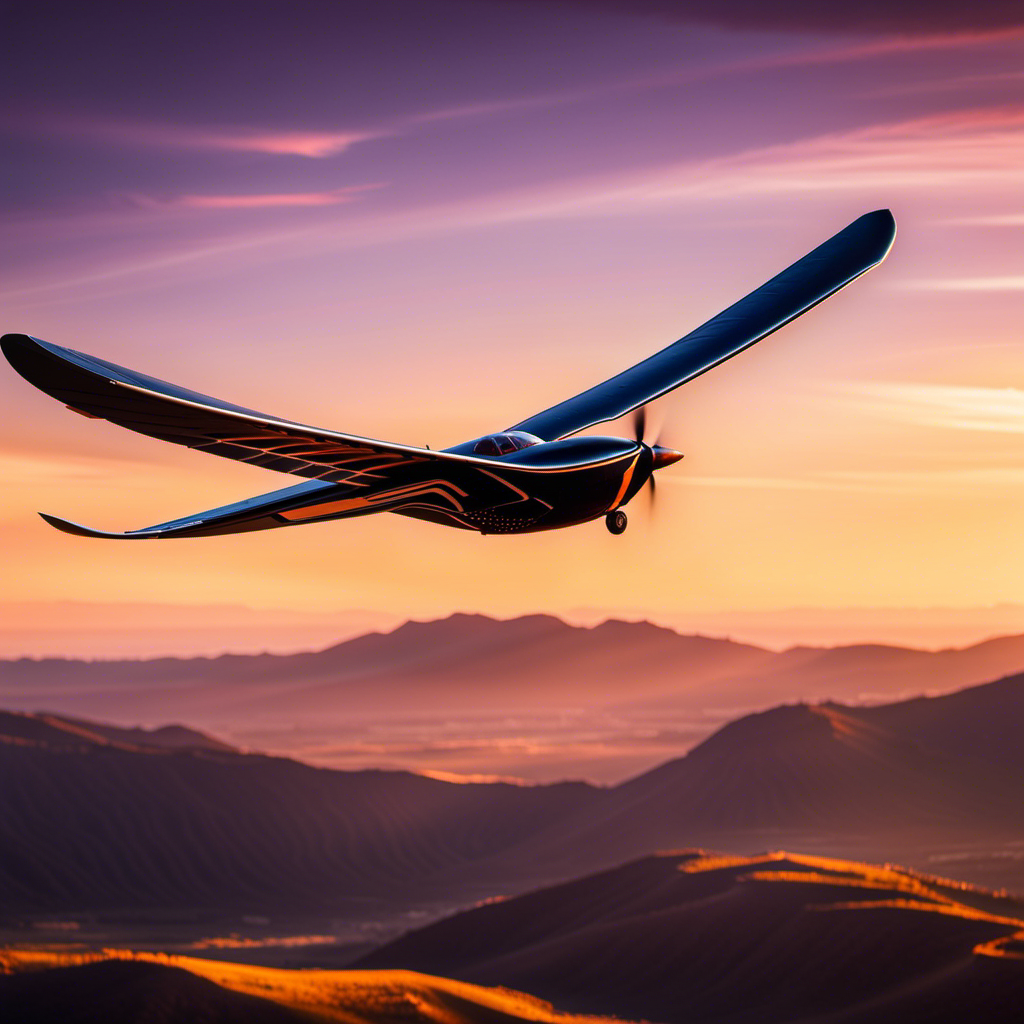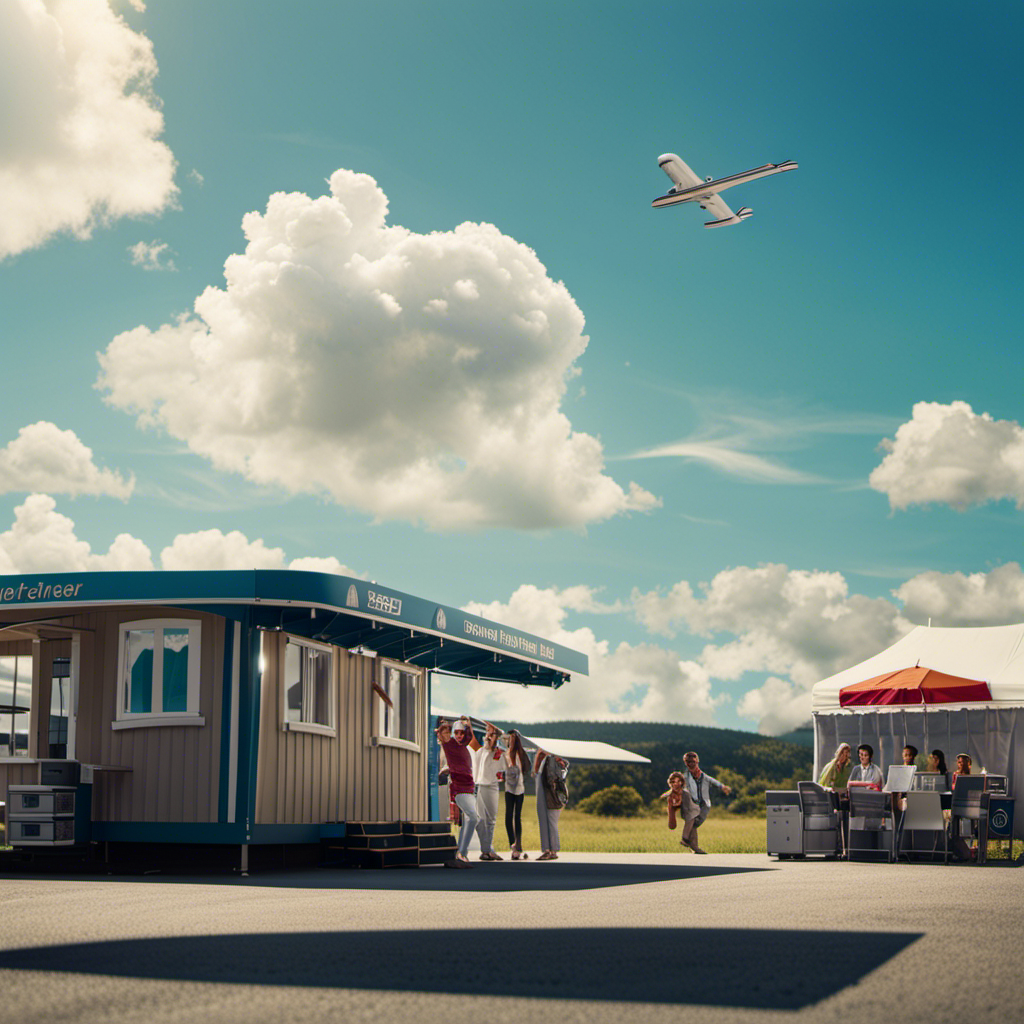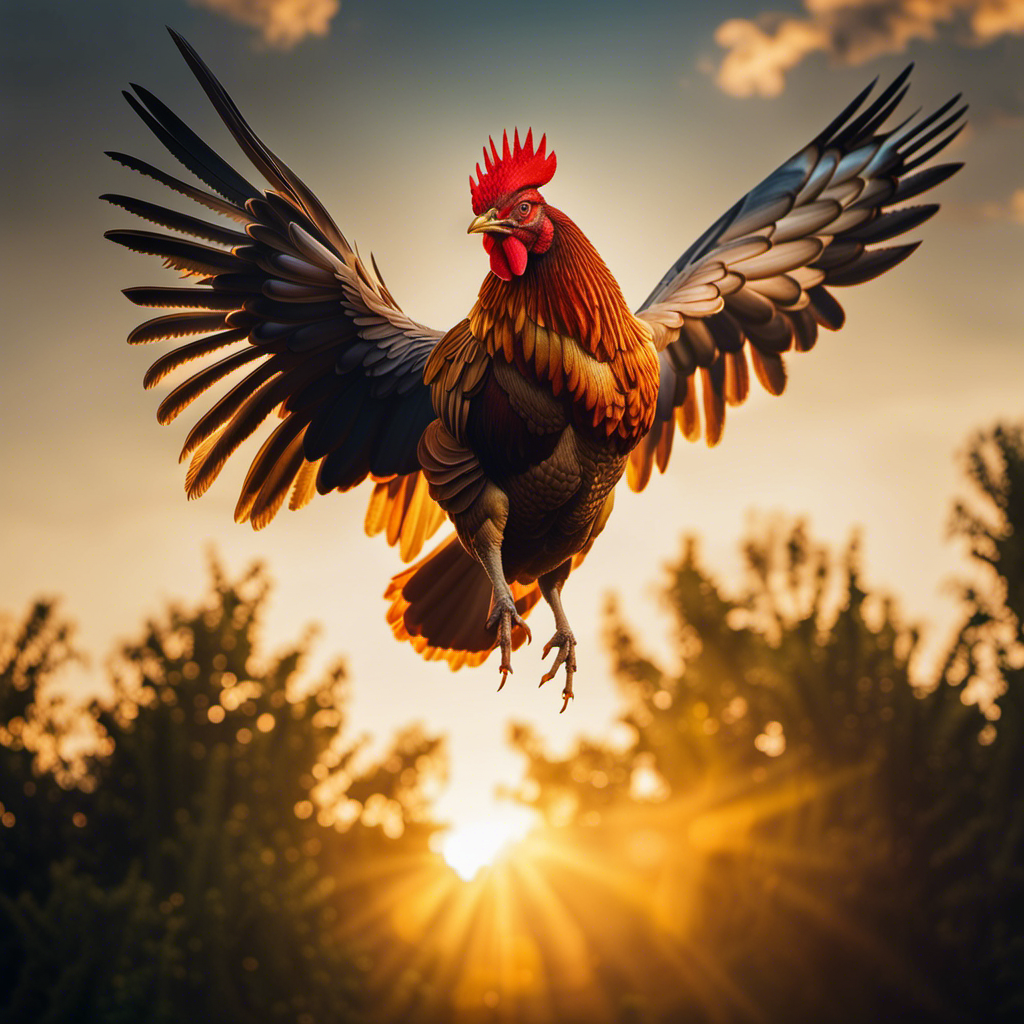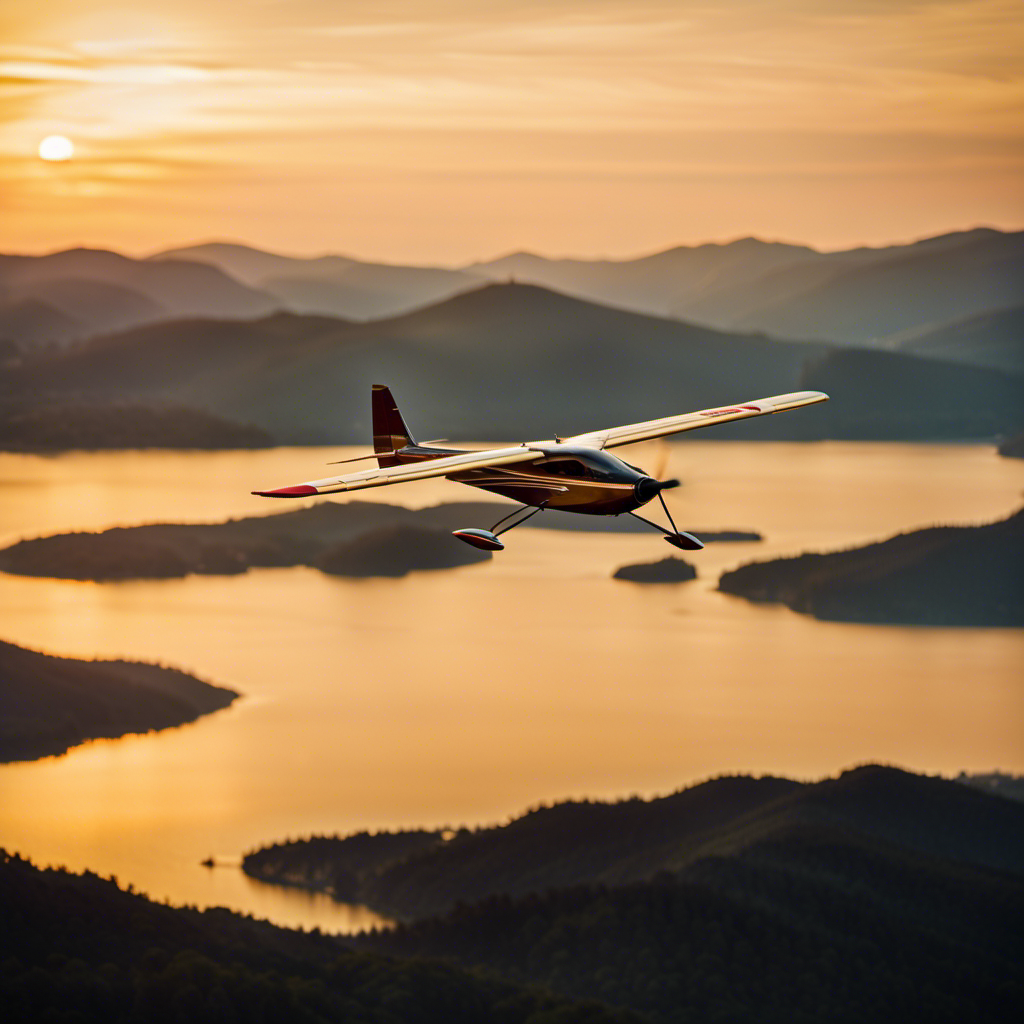Flying above the clouds, I often wonder about the amount of time a glider can stay in the air. This question intrigues both enthusiasts and pilots as we push the boundaries of aerial navigation.
In this article, we’ll delve into the fascinating world of glider flight, exploring the science behind soaring, the factors that affect flight duration, and the incredible records set by daring aviators.
Join me as we uncover the challenges, risks, and the limitless freedom that comes with gliding.
Key Takeaways
- Gliders rely on lift generated by their wings to stay airborne.
- Thermals and updrafts can be used to gain altitude and extend flight time.
- Ridge and wave lift allow gliders to gain altitude without thermals or updrafts.
- Factors such as favorable weather conditions, glider design, and pilot skill contribute to longer flight durations.
The Basics of Glider Flight
You’ll need to understand the basics of glider flight if you want to know how long a glider can fly. The physics of gliding and glider design principles play a crucial role in determining the duration of a glider’s flight.
Gliders rely on the principle of lift to stay aloft. Lift is generated by the interaction of the glider’s wings with the air, and it counteracts the force of gravity. To maximize lift, gliders are designed with long, slender wings and a streamlined fuselage. This allows them to generate the necessary lift while minimizing drag.
Additionally, gliders can make use of thermals, updrafts of warm air, to gain altitude and extend their flight time. Understanding these principles and design features sets the foundation for exploring the science behind soaring.
The Science Behind Soaring
When it comes to glider flight, understanding the science behind soaring is crucial. Three key points to delve into are lift and airflow, thermals and updrafts, and ridge and wave lift.
Lift and airflow are directly related, with lift being generated by the interaction between the glider’s wings and the surrounding air.
Thermals and updrafts, on the other hand, are natural occurrences that can provide gliders with the necessary lift to stay aloft for extended periods of time.
Lastly, ridge and wave lift occur when wind encounters a slope or a mountain, creating upward currents that gliders can harness to gain altitude and extend their flight.
Lift and Airflow
To achieve lift and maintain airflow, it is important to ensure that the glider’s wings are properly positioned and angled. The design of the wings plays a crucial role in the performance of the glider. Here are some key factors to consider:
-
Wing shape: The wings should have a sleek design with a high aspect ratio. This allows for efficient airflow over the surface.
-
Wing camber: The upper surface of the wings should have a slight curve. This helps generate lift by creating a pressure difference between the upper and lower surfaces.
-
Winglets: Winglets are small vertical fins located at the wingtips. They reduce drag caused by the formation of vortices, improving overall aerodynamic efficiency.
-
Wing loading: Wing loading is determined by dividing the weight of the glider by the wing area. Lower wing loading allows for better lift and maneuverability.
-
Wing dihedral: The wings should have an upward angle from the horizontal axis. This helps stabilize the glider during flight.
Understanding these principles of glider design is essential for maximizing lift and airflow. These concepts will be further explored in the next section on thermals and updrafts.
Thermals and Updrafts
Thermals and updrafts are natural phenomena that glider pilots can use to gain altitude and extend their flight time.
Thermals are columns of rising warm air that occur when the sun heats the ground, causing the air above it to rise. Glider pilots can detect thermals by observing indicators such as cumulus clouds or dust devils. Once in a thermal, the pilot can circle within it, climbing higher and higher.
Updrafts, on the other hand, are rising currents of air caused by terrain features like hills or mountains. Glider pilots can fly close to these features to take advantage of the upward air movement.
Ridge and Wave Lift
By flying along the ridge line, you can take advantage of the upward air currents created by the wind hitting the terrain. This phenomenon is known as ridge lift and is one of the techniques glider pilots use to extend their flight duration.
Ridge lift occurs when the wind blows against a ridge or mountain, causing the air to rise up along the slope. As the glider flies close to the ridge, it experiences the rising air and gains altitude without the need for a thermal or updraft. The intensity of the ridge lift depends on factors such as the angle and shape of the ridge, wind speed, and stability of the atmosphere.
Another form of lift that can contribute to longer flights is wave lift, which occurs when the wind encounters a mountain range and creates standing waves in the atmosphere. These wave dynamics can provide gliders with sustained upward motion, allowing them to stay aloft for extended periods.
Transitioning into the next section, other factors affecting glider flight duration include weather conditions and pilot skill.
Factors Affecting Glider Flight Duration
You can increase the duration of your glider flight by considering various factors.
To maximize your time in the air, take into account the following:
-
Weather conditions: Favorable weather, such as steady winds and thermals, can significantly extend your flight duration.
-
Glider design: Opt for a glider with a high glide ratio and efficient wings to minimize drag and maximize lift.
-
Pilot skill and technique: A skilled pilot who can read the air and make precise adjustments will be able to stay aloft longer.
By taking these factors into consideration, you can greatly increase the duration of your glider flight.
Now, let’s explore the world records for glider flight duration, where pilots have pushed the limits of what is possible in terms of staying airborne.
World Records for Glider Flight Duration
To achieve record-breaking flight durations, pilots must rely on favorable weather conditions, advanced glider designs, and exceptional skills.
Throughout history, there have been remarkable glider flights that have set world records and pushed the boundaries of what is possible. One such historical flight took place in 1952 when a team of German pilots flew a glider for an astonishing 56 hours and 15 minutes. This feat was made possible by taking advantage of a weather system that provided continuous lift, allowing the glider to stay aloft for an extended period.
These world records serve as a testament to the advancements in glider technology and the skill and determination of the pilots who strive for greatness.
Now, let’s delve into the longest glider flights in history, where pilots have pushed the limits even further.
Longest Glider Flights in History
If you want to learn about the longest flights ever achieved in a glider, prepare to be amazed by the incredible distances covered and the endurance demonstrated by these skilled pilots. The longest glider flight records are a testament to human ingenuity and the pursuit of pushing the boundaries of what is possible in aviation.
Techniques for maximizing glider flight time include:
- Soaring in thermals: By locating and riding thermal updrafts, gliders can stay aloft for extended periods.
- Ridge soaring: Utilizing the wind that is forced up by a mountain range, gliders can fly along the ridge for extended distances.
- Wave soaring: Taking advantage of standing waves in the atmosphere, gliders can climb to great heights and cover vast distances.
- Energy management: Pilots use precise control of speed and angle of attack to minimize drag and maximize efficiency.
By employing these techniques, glider pilots have achieved remarkable flight durations.
Now, let’s delve into strategies for extending glider flight time further.
Strategies for Extending Glider Flight Time
When it comes to extending glider flight time, there are several key points to consider.
First and foremost, finding and utilizing lift is crucial. This involves understanding the different types of lift and how to effectively exploit them.
Additionally, energy management techniques play a vital role in maximizing flight duration. This includes optimizing speed and altitude to conserve energy.
Lastly, planning and navigation are essential for determining the most efficient routes and making strategic decisions during the flight.
Finding and Utilizing Lift
You can use thermals to help your glider find and utilize lift, allowing it to stay airborne for longer periods of time. Thermals are columns of warm air that rise from the ground due to heating by the sun. By understanding how to find and exploit thermals, you can maximize your glider’s flight time.
Here are three important techniques for utilizing thermals effectively:
-
Recognize visual cues: Look for signs of thermals such as cumulus clouds, birds circling in a specific area, or dust devils rising from the ground. These visual cues can indicate the presence of rising air and help you locate thermals.
-
Center your glider in the thermal: Once you’ve found a thermal, position your glider in the center of the column. This allows the glider to gain the maximum lift and upward motion from the thermal.
-
Spiral climb technique: To exploit the thermal efficiently, use the spiral climb technique. This involves circling within the thermal, gradually increasing your altitude while maintaining a constant bank angle.
By effectively finding and utilizing thermals, you can extend your glider’s flight time significantly.
Now, let’s explore energy management techniques to further optimize your glider’s performance.
Energy Management Techniques
To maximize your flight time, it’s important to effectively manage the energy of your glider. Energy conservation and flight efficiency are crucial factors in determining how long a glider can stay airborne. By employing various energy management techniques, pilots can extend their flight duration and cover greater distances.
One such technique is adjusting the speed of the glider to optimize its glide ratio. Slowing down the glider reduces the rate of energy loss, allowing it to stay aloft for longer periods.
Another technique is utilizing thermals and ridge lift to gain altitude, conserving energy by using the natural movement of air. Additionally, maintaining a smooth and stable flight path minimizes drag and maximizes energy efficiency.
By implementing these energy management techniques, pilots can significantly increase their flight time and explore new horizons.
Moving forward into the next section on planning and navigation, it is essential to create a strategic flight plan to make the most of the available energy and find optimal routes for sustained flight.
Planning and Navigation
Creating an effective flight plan is crucial for maximizing energy efficiency and finding the best routes for sustained navigation. As a glider pilot, I rely on a set of planning strategies and navigation techniques to ensure a successful flight.
Here are four key elements that I consider when creating my flight plan:
-
Weather analysis: I carefully analyze the weather conditions to identify favorable wind patterns, thermals, and potential areas of turbulence. This information helps me choose the most efficient route and avoid unfavorable conditions.
-
Route optimization: I use advanced navigation tools to plan my route, taking into account factors such as airspace restrictions, obstacles, and optimal gliding paths. By carefully selecting waypoints and adjusting my flight path, I can maximize my glider’s range and minimize energy consumption.
-
Energy management: I constantly monitor my glider’s energy state, such as altitude and airspeed, to ensure efficient use of available resources. By utilizing soaring techniques like ridge lift and thermal soaring, I can extend my flight duration and cover longer distances.
-
Contingency planning: I always have backup plans in place, including alternative landing sites and emergency procedures. This allows me to adapt to changing conditions and handle unexpected situations during the flight.
Challenges and Risks of Extended Glider Flights
As a pilot, one must be aware of the challenges and risks associated with extended glider flights. Two key points to consider are fatigue and physical endurance, as well as emergency landings and safety measures.
Fatigue can impair concentration and decision-making abilities, making it crucial to manage rest periods and stay vigilant during long flights.
Additionally, understanding emergency landing procedures and having proper safety measures in place is essential for mitigating potential risks and ensuring a safe flight.
Fatigue and Physical Endurance
You’ll need to make sure you’re physically prepared for the fatigue and physical endurance required to fly a glider for an extended period of time. Extended glider flights can be physically demanding, and it is crucial to manage fatigue effectively. Here are some important factors to consider for fatigue management and to mitigate the physiological effects:
- Adequate rest and sleep prior to the flight to ensure optimal physical and mental performance.
- Proper nutrition and hydration to maintain energy levels and prevent dehydration.
- Regular stretching and exercises to improve blood circulation and reduce muscle fatigue.
- Utilizing ergonomic seating and postural techniques to minimize discomfort and prevent muscle strain.
Managing fatigue is essential as prolonged flying can lead to decreased alertness, impaired decision-making, and reduced physical capabilities. By prioritizing rest, nutrition, exercise, and ergonomic practices, you can enhance your endurance and reduce the negative physiological effects of extended glider flights.
Transitioning to the subsequent section about emergency landings and safety measures, it is crucial to have a plan in place to ensure a safe landing in case of unforeseen circumstances.
Emergency Landings and Safety Measures
To ensure your safety during unexpected situations, it is important to have a well-defined plan for emergency landings. As a glider pilot, I understand the importance of being prepared for any potential emergency. Emergency procedures and landing techniques are crucial to master in order to safely navigate unplanned landing situations.
In the event of an emergency, it is important to remain calm and assess the situation quickly. Activate the emergency locator transmitter (ELT) and communicate your intentions to air traffic control. Choose a suitable landing site, considering factors such as terrain, wind direction, and obstacles. Maintain a controlled descent and approach, focusing on a smooth touchdown.
By practicing emergency procedures and mastering landing techniques, glider pilots can ensure their safety during unexpected events.
Transition: Now that we have discussed emergency landings and safety measures, let’s delve into the world of gliding competitions and events.
Gliding Competitions and Events
Don’t miss out on the exciting gliding competitions and events happening this season! Gliding competitions bring together the best pilots and showcase the incredible capabilities of glider design and pilot skills.
Here are some must-see events:
-
National Gliding Championships: Witness top pilots battle it out in various categories, pushing the limits of their gliders to achieve maximum performance.
-
Cross-Country Races: Experience the thrill as pilots navigate challenging routes, relying on their skills and the efficiency of their gliders to cover long distances.
-
Aerobatic Displays: Marvel at the precision and grace of aerobatic gliders as they perform breathtaking maneuvers, showcasing the versatility of glider design.
These events not only provide entertainment but also offer valuable insights into the advancements in glider technology and the skills required to excel in this exhilarating sport.
Now, let’s explore the future developments in glider technology that promise to revolutionize the sport even further.
Future Developments in Glider Technology
Get ready for some exciting advancements in glider technology that are set to revolutionize the sport!
The future of gliding holds incredible potential with the introduction of innovative materials and designs. One of the key areas of focus is the use of sustainable materials, which not only reduces the environmental impact but also improves the performance of gliders.
Manufacturers are exploring new composite materials that are lightweight, yet durable, allowing for greater maneuverability and efficiency. Additionally, advancements in aerodynamics and wing design are being developed to enhance lift and reduce drag, enabling gliders to stay aloft for longer periods.
This combination of future innovations and sustainable materials will undoubtedly shape the glider industry and open up new possibilities for glider pilots.
Now, let’s explore the limitless freedom of glider flight and the incredible experiences it offers.
Conclusion: The Limitless Freedom of Glider Flight
The incredible experiences offered by glider flight are a testament to the limitless freedom it provides. As a glider pilot, I am constantly amazed by the ability to soar through the sky with no engine, relying solely on the forces of nature.
However, it is important to acknowledge the limitations of glider flight. Unlike powered aircraft, gliders are unable to sustain flight indefinitely. The duration of a glider flight depends on various factors such as weather conditions, thermal activity, and the pilot’s skill in exploiting lift.
Long duration flights can be mentally challenging, as pilots must stay focused and alert for extended periods of time. The psychological aspects of these flights require pilots to maintain a high level of concentration and decision-making ability.
Despite these limitations, the freedom and serenity experienced during glider flight make it an unparalleled adventure.
Frequently Asked Questions
What is the average cost of owning and maintaining a glider?
The average cost of owning and maintaining a glider can vary depending on factors such as the model, age, and usage. Expenses can include hangar fees, inspections, repairs, and insurance. Regular maintenance is crucial to ensure the safety and performance of the glider.
Can gliders be used for commercial or passenger transportation?
Glider safety and commercial regulations are important factors to consider when exploring the use of gliders for passenger transportation. Ensuring proper training, maintenance, and adherence to regulations is crucial for a successful and safe operation.
Are there any restrictions on where gliders can fly?
Restricted airspace and safety regulations dictate where gliders can fly. Certain areas, such as airports and military zones, are off-limits. Additionally, gliders must adhere to specific altitude restrictions and airspace rules to ensure safe and controlled operations.
How does weather affect the duration of a glider flight?
Weather conditions greatly impact glider flight performance. Strong winds, turbulence, and low visibility can shorten the duration of a flight. Safety considerations are crucial, as adverse weather can pose significant risks to glider pilots.
Are there any health or physical requirements for operating a glider?
To operate a glider, there are several health and physical requirements. Pilots must have good vision, be free from certain medical conditions, and possess sufficient physical strength and coordination to handle the controls and endure the demands of flying.
Conclusion
As I reflect upon the boundless skies and the mesmerizing dance of the gliders, I am filled with a sense of awe and wonder. The glider, with its graceful wings and skillful maneuvers, embodies the pure essence of freedom and flight. It defies the limitations of time and space, soaring effortlessly through the heavens.
Like a bird riding the currents of the wind, a glider can fly for hours upon hours, traversing great distances with ease. It is a testament to the ingenuity of human engineering and the indomitable spirit of exploration.
With each passing moment, the glider teaches us that there are no boundaries to our aspirations, no limits to our dreams. It is a symbol of our collective desire to reach new heights and push the boundaries of what is possible.
So let us take to the skies, my friends, and embrace the limitless freedom of glider flight.
Orion, better known as “Jetstream,” is the voice that brings the stories of the skies to life. His fascination with aviation began at a young age, sparked by his father’s tales of flying and adventure. Orion’s journey into the world of gliding was serendipitous, and from the moment he took his first glider flight, he knew he had found his calling.










